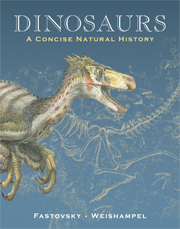Book contents
- Frontmatter
- Contents
- Why a natural history of dinosaurs?
- Dedication
- Part I Reaching back in time
- Part II Ornithischia: armored, horned, and duck-billed dinosaurs
- Part III Saurischia: meat, might, and magnitude
- 8 Sauropodomorpha: the big, the bizarre, and the majestic
- 9 Theropoda I: nature red in tooth and claw
- 10 Theropoda II: the origin of birds
- 11 Theropoda III: early birds
- Part IV Endothermy, endemism, and extinction
- Glossary
- Figure credits
- Index of subjects
- Index of genera
10 - Theropoda II: the origin of birds
- Frontmatter
- Contents
- Why a natural history of dinosaurs?
- Dedication
- Part I Reaching back in time
- Part II Ornithischia: armored, horned, and duck-billed dinosaurs
- Part III Saurischia: meat, might, and magnitude
- 8 Sauropodomorpha: the big, the bizarre, and the majestic
- 9 Theropoda I: nature red in tooth and claw
- 10 Theropoda II: the origin of birds
- 11 Theropoda III: early birds
- Part IV Endothermy, endemism, and extinction
- Glossary
- Figure credits
- Index of subjects
- Index of genera
Summary
Chapter objectives
Understand birds as theropod dinosaurs
Learn about the origin of flight
Refine our cladograms as a tool for investigating evolution
Birds
Birds are dinosaurs
Birds are dinosaurs. We don't mean that they are related to dinosaurs – although, if they are dinosaurs, they must be related them. We don't mean that they come from dinosaurs – although they obviously evolved from something that was itself a dinosaur. We mean that birds are dinosaurs, a statement that, as this chapter unfolds, will be no more radical than saying that humans are mammals.
So how do we figure out who birds are related to? The same way that we explored in Chapter 3: using diagnostic characters. Here we choose those features that might be easily observed in a fossil.
Diagnostic features of living birds
Among living vertebrates, birds possess a remarkable and largely unique suite of diagnostic features (Figure 10.1 and Table 10.1).
Feathers. All living birds have feathers – complex, distinctive structures that consist of a hollow, central shaft that decreases in diameter toward the tip. Radiating from the shaft are barbs, feather material that, when linked together along the length of the shaft by small hooks called barbules, form the sheet of feather material called the vane (Figure 10.1a). Feathers with well-developed, asymmetrical vanes are usually used for flight and are therefore called flight feathers.
- Type
- Chapter
- Information
- DinosaursA Concise Natural History, pp. 212 - 234Publisher: Cambridge University PressPrint publication year: 2009

